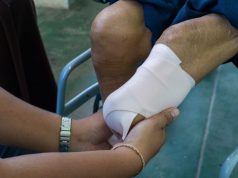No racial or sex disparities seen for risk for amputation after periprosthetic joint infections
TUESDAY, May 28, 2019 (HealthDay News) — Lower socioeconomic status is associated with an increased risk for above-knee amputation (AKA) after periprosthetic joint infection (PJI) of the knee, according to a study recently published in Clinical Orthopaedics and Related Research.
Alexander M. Lieber, from Drexel University in Philadelphia, and colleagues used data from the National Inpatient Sample (2010 to 2014) to identify 912 AKAs (52 percent male) among 32,907 PJIs of the knee (3 percent of all PJIs of the knee).
The researchers found that compared with the wealthiest income quartile by ZIP code, patients in the lowest income quartile by ZIP code were more likely to sustain an AKA (odds ratio [OR], 1.58; 95 percent confidence interval [CI], 1.25 to 1.98; P < 0.001). Patients with Medicare (OR, 1.94; 95 percent CI, 1.55 to 2.43; P < 0.001) and Medicaid (OR, 1.86; 95 percent CI, 1.37 to 2.53; P < 0.001) were at higher risk for AKA versus patients with private insurance. There were no significant differences regarding risk for AKA among white patients (OR, 0.99; 95 percent CI, 0.77 to 1.26; P = 0.936) and black patients (OR. 0.95; 95 percent CI, 0.69 to 1.30; P = 0.751) versus other races. Additionally, male patients did not have a greater risk for undergoing AKA versus female patients (OR, 1.02; 95 percent CI, 0.88 to 1.29; P = 0.818).
“Surgeons should be cognizant when treating PJI in patients from lower income backgrounds, as these patients may be at greater risk for AKA,” the authors write.
Abstract/Full Text (subscription or payment may be required)
Copyright © 2019 HealthDay. All rights reserved.








